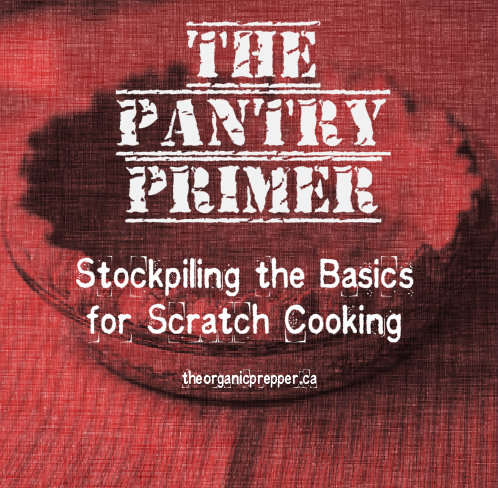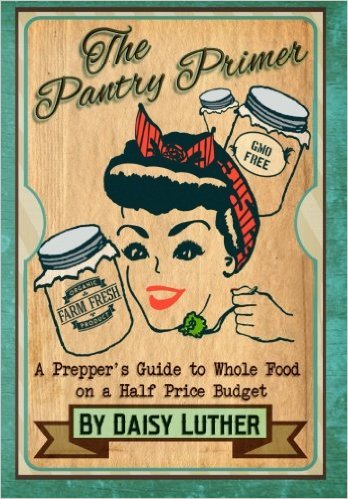If you're new here, you may want to subscribe to my RSS feed. Thanks for visiting!
To be efficient, every pantry requires certain basics that allow for scratch cooking. A good pantry should have everything you need to whip together a pie, a loaf of bread, or a batch of biscuits with no trip to the store required.
Many of these basics can be purchased in large quantities. One of my favorite destinations for pantry basics is Amazon, where I purchase yeast, aluminum-free baking soda, and other building blocks of a scratch pantry. I have also acquired 50-pound bags of organic sugar at Bulk Barn for a reduced price.
What basics do you need?
To build your stockpile, look through your cupboards and see what you use the most. Every kitchen will be different but below are my most-used items – the ones that I search out and buy in bulk.
Baking Items:
- Baking soda
- Baking powder
- Yeast
- Cocoa
- Nonfat dry milk
- Alternative Flours
Fats:
- Olive oil
- Coconut oil
- Shortening
- Butter
- Lard
Sweeteners:
- White sugar
- Turbinado sugar
- Muscavado sugar/brown sugar
- Honey
- Molasses
- Maple syrup
Other:
- Salt
- White vinegar
- Apple cider vinegar
- Balsamic vinegar
- Black pepper
- Herbs and spices
- Cornstarch (please consider organic for all corn products)
Want to learn more? The new edition of The Pantry Primer is now available!
Lots of us like to have hard copies of information that we’ve found helpful. Because of this, I’ve expanded on the information included in this series and put it all in one handy primer, available on Amazon.

















A persons food pantry should have spices and cooking items, no doubt. But it also needs to be with the items you are familiar at cooking with.
Our food pantry is closed to filled with only some space left. We have mostly easy, albeit boring, stuff such as quick oats, rice, dehyed potato flakes, canned soup, powdered milk, beans, and a few others.
Your list looks good. I’ll need to add a few of those in bulk quantities.
If I buy these in bulk, how can I extend their shelf life? Yeast, baking powder & soda all have experience dates.
You can freeze yeast to keep it almost indefinitely. I’m on the verge of using up a bag that I bought 2 years ago, and the yeast still works just fine. I always proof it in a little warm water with a bit of sugar, even if the recipe doesn’t call for it, just to make sure that it’s still okay.
Actually baking soda has an indefinite shelf life. You can add cream of tarter to baking soda, 2 parts tarter to one part soda in order to make baking powder. Cream of tarter also has an indefinite shelf life if stored in an airtight container and kept dry.
Stealth Spaniel some things you can’t extend the shelf life of but you can rotate your pantry. So don’t just stock the items but use the stuff in there and restock on a regular basis so things aren’t going bad, yet you have a good supply.
Thanks Trista! For those who read my comment- I meant “expiration”, not experience. Good Grief! Apologies.
The important element to your food storage is KNOWLEDGE. The time to learn how to cook from scratch is NOT when you are in a dire situation. It sounds like many of you have food storage that is packed away for “someday”. Will you even know what to do with it? Rotating your food supply is essential, not just to keep it fresh, but also so that you will know what to do with it and the food will be familiar to your family. In the case of a disaster, having to learn how to prepare whole grain wheat and grow vegetables all while under the stress of a disaster would be extremely difficult and possible too much of a strain to be successful at it. In addition, you will know how your family will respond to the emergency diet. It would be a shame to discover food allergies to the only food you have available.
I couldn’t agree more with you!! Each September me, my fiance, and our now 6 y/o go 24hrs totally off grid and only use the preps and items at hand. It’s actually quite fun and you learn SO much! The best tool is knowledge like you said, and also experience. Learning from the mistakes that you make, it’s always the small things that make such a huge difference in the end when it comes to prepping! Thanks for the article, I just stumbled upon your website and absolutely love it!!! It is by far my favorite I have come across! Will be back everyday! Already printed off 10 articles! hehe 🙂
Depends what you are stockpiling for. To save money? Or to be prepared in a disaster?
I live in Christchurch, New Zealand; our country sits on the Ring of Fire but ‘the big one’ was always expected to hit Wellington, not Christchurch. 4 Sept 2010 we were shaken by a M7 quake and thought we had dodged a bullet with no fatalities and little real damage considering the size of the quake. Hundreds of aftershocks later, the ‘big one’ M6.3 hit 22 Feb 2011 even closer to town and was more than 2x gravity – the most acceleration ever recorded in an urban area. More significant aftershocks in June 2011 with two M6.3s in one day.
After each significant aftershock (high 4s, 5s, 6s) power would be out, shops would be closed, water might not be available. Roads would be closed (many are still closed 4+ years later) and you might take hours to get home. In February, we went without power for a week and without water for a month – and we were among the lucky ones. There were major cleanups to do (kitchens were the worst), queues to get through (petrol, traffic), and banks/ATMs were closed due either to breakdowns or to the people working there also needing to tend to families and housing issues. Even when stores were open, supplies were limited as roads and tracks in and out were damaged, and the port was closed. And it didn’t just effect Christchurch – as we are the gateway to a lot of the South Island, other towns were also affected.
The whole point of all of this is, decide what you are stockpiling for, and plan accordingly. If it’s a disaster, you may be cooking on a BBQ grill. Pots of pasta from scratch might not be something you are up to doing. Fancy meals won’t be, either. Our stockpiles now include plenty of open-and-eat type foods. It’s what we wanted most – appetites were shot to hell, stress levels were well up there, and we just wanted something to easy to eat. Then again, we knew there was an end in sight; had it continued indefinitely, then sure, we would have wanted some more variety and as we grew more accustomed to the ‘new normal’ we would have wanted more complex meals.
If you have kids, make sure you have their fave foods. Make sure you have your fave foods. Don’t forget snacks. When you do eat, you want it to not only be easy, but something you actually would eat on any busy day.
Some of the things I now keep on hand – unopened packs of tortillas, pita bread, little convenience packs of mayonnaise (remember: you may not have refrigeration, and for me that was my ‘I need this’ food), a couple cans of Spam, cans of soup, a can of Pringles, some minute rice, cans of beans, cans of fruit, etc. Open and eat, mostly.
What I stockpile to save money is different.